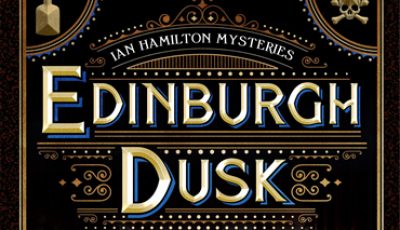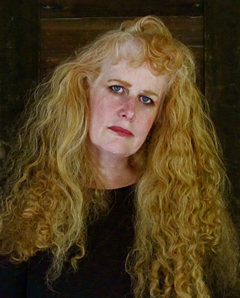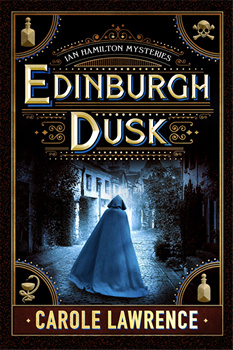

Edinburgh Dusk by Carole Lawrence
With the arrival in 2017 of Edinburgh Twilight, a historical mystery featuring as its protagonist Detective Inspector Ian Hamilton, Carole Lawrence won a large, enthusiastic readership. Also writing as C. E. Lawrence and Carole Bugge, she has nine published novels, six novellas and a dozen or so short stories and poems to her credit. Her work has received starred reviews from Kirkus, The Library Journal, Publisher’s Weekly, Booklist, The Boston Herald, Ellery Queen—the list goes on.
In her newest release in the series, EDINBURGH DUSK, Lawrence weaves a delicious mystery yet again. A female physician, Sophia Jex-Blake, calls on Detective Inspector Ian Hamilton to investigate the suspicious death of one of her patients—a railroad lineman who may have been poisoned. For the first time since a fire killed his parents, Hamilton enters the Royal Infirmary to ask for the insights of a certain brilliant medical student named Arthur Conan Doyle.
Lawrence took The Big Thrill behind the scenes of her writing process, to show just how she evokes a dark-tinged page-turning story set in the middle of a Scottish winter in the late 19th century.
What drew you to 19th century Scotland as a setting?
The first time I saw Scotland, I felt like I had found my people. I remember seeing a lock keeper when I was traveling on a canal boat—a tall, rather-unhinged woman with crazy red hair and pale skin who kept yelling at us in this thick Glaswegian accent, and I thought at the time she was like a more deranged version of myself, a kind of Scottish Doppelganger. (I’m still alive, so I guess she wasn’t really my Doppelganger.)
But when I’m in Scotland, I feel like I’m home (my family has deep and ancient roots in the U.K., so it’s maybe not that strange). The landscape feels like it’s been tattooed onto my soul—familiar and welcoming in all its wildness.
And Edinburgh itself carries the weight of so much history; it seeps from the cobblestones. It just sucked me right in—I wandered around in a kind of trance. You can sense its origins as a medieval city. But I’m more comfortable in the 19th century, having written a bunch of Sherlock Holmes stories (as well as two novels and one musical). That period speaks to me and arouses my curiosity—it was a time of upheaval and growth like no other in arts and sciences, especially in Edinburgh, which was in many ways the intellectual center of what is now the U.K.
You are also a poet, a composer, and a playwright. How do those disciplines inform your fiction?
When I write fiction, I try to apply what I’ve learned as a poet—I’m always thinking about using fewer words, streamlining my prose, finding unique and striking ways to describe things, choosing sensory details carefully, applying metaphor and allegory where appropriate, etc. I care a lot about the beauty and sound of language, and the flow of a line of prose.
As for being a composer, I’ve always been an aural person, so as I write I always hear the words. I work hard to get the music into my writing, even if it means reworking a sentence a dozen times. I can’t walk away until it sounds right.
Plays were probably the first thing I ever wrote—I used to write what I thought of as witty satires about my parents and their drunken bridge games, their gourmet club, etc. I’d conscript my siblings and any neighborhood kids who were willing, and put on “productions” in the back yard, with flannel blankets strung over the clothes lines as “curtains.”
I’m sure they were dreadful, but I do think writing plays taught me that with dialogue, less is more. If a line doesn’t get a laugh, advance the plot, or show character relationships, out it goes. I try to apply that same principle in my fiction—as well as trying to ensure that each character’s dialogue is unique to him or her.
What sources did you draw on to create your main character, Ian Carmichael Hamilton?
From the beginning, I envisioned him as a sort of prototype of Sherlock Holmes, physically and intellectually. So he’s tall and thin and smart, but kind of cut off emotionally. His emotional life just grew as I spent more time with him. Unlike Holmes, he’s a neat freak, and he’s not really on the spectrum, just emotionally stunted. Believe it or not, I didn’t even think about him as an actual model for Holmes—it was only much later that it occurred to me that Conan Doyle himself might appear as a character in the series.
Creating characters is kind of sculpting with clay. I’m not a sculptor, but it just seems like the same process—you put a little clay on, shape it, take a little off, put a little more on in another place, etc.
And your “clay” can come from anywhere, really. For instance, the idea of Ian having a burn scar on his shoulder came to me when I was watching a British crime show in which one of the characters had a nasty scar. I thought something like that would make a good literal and metaphorical wound for Ian, and that led to the idea he got it in a fire, which led to the idea that his parents had died. So as a writer, I’m a bit of a magpie—I’ll take bits and scraps of ideas wherever I can find them!
You have such interesting colleagues for him. How did you research the lives, responsibilities, and work procedure of law enforcement?
There is so much good original source material out there. I visited the Museum of the City of Edinburgh, spoke with law enforcement personnel in the U.K., and did tons of research on the internet, of course.
But the coolest sources were memoirs written by real life Scottish detectives in that era. The most famous is James McLevy (1796–1875), Edinburgh’s first detective, who handled over 2,200 cases, apparently securing a conviction nearly every time. He wrote the immensely popular Curiosities of Crime in Edinburgh, Sliding Scale of Life and The Disclosures of a Detective. Some people think he inspired Conan Doyle’s work—Doyle would almost certainly have been aware of his books, and probably read them. McLevy also got forensic advice from the University of Edinburgh’s medical faculty. But I actually prefer the memoirs of the lesser known Archie Carmichael, who wrote The Casebook of Glasgow’s Victorian Detective. He writes with a gleeful wry humor and a dark wit which is singularly Scottish. Born in 1842, he was working as a detective in Glasgow right at the same time my novels take place. I highly recommend his writings.
Did you always intend to write this as a series? If so, what are the challenges of a historical series?
These days I think it’s a good idea to plan a book as part of a series—publishers tend to be attracted to series, because they can grow a writer’s audience. So yes, I had the idea for the second book before I finished the first. And then I was lucky Thomas & Mercer was interested in continuing it as a series.
As to challenges, it has become increasingly clear to me that no matter how exhaustive your research is, you will always get something wrong. And there are people out there—bless them—who just live to write reviews in which they enumerate just what you missed. This actually worked in my favor with my first Sherlock Holmes novel, The Star of India. Some smart readers listed a few things I got wrong—and of course they were right—and I was able to correct the mistakes when the book was reprinted by Titan Books. So thanks, guys—well done.
I love character detail and you do a wonderful job in this novel. What are your secrets in establishing characters with descriptive detail?
First of all, thank you so much—that means a lot to me. I probably work harder on descriptive detail than anything else—I rewrite endlessly. That’s true for both setting and character descriptions. I have a lot of painter friends, and I’m always amazed by the way they evoke a mood and setting through use of color and form. I try to paint with words, I guess.
I’m drawn to writers who do the same—if I can’t see a character, I can’t feel them. And the more time I spend with characters, the more I get to know them. Sometimes it’s just a matter of sitting back and watching your characters in action—follow them around the room, as it were. I need to hear their voices, see the sweat on their faces. It’s a bit of a spooky process, and you can’t rush it. If I can’t experience them as fully formed people, then I’m pretty sure my readers can’t.
What novelists have inspired you?
I feel like I’m influenced on some level by everything I read, even if I don’t care for it at the time. But I come from a pretty conservative classical background in so-called literary fiction. I love all the Russians, especially Tolstoy and Dostoevsky. Also Thomas Mann, Gunter Grass, Flaubert, Heinrich Boll, Hugo, Voltaire, and magic realists like Isaac Singer, Kundera—and so many others. Friedrich Durrenmatt wrote an amazing detective novel The Judge and His Hangman, which I read in German when I was in college. It’s just astonishing. There are some interesting magical realists writing now, some of them Israeli. I’m sort of partial to European writers, I guess, looking at that list, but I have a smattering in South American writers, notably Borges and Marquez.
But I also enjoyed American writers, many of them women, like Shirley Jackson, Flannery O’Connor, Eudora Welty, Katherine Anne Porter, Willa Cather, Edith Wharton, Kate Chopin.
I also was really impressed by Hemingway, Fitzgerald, Roth, Dreiser, and Sinclair Lewis. And the ones I call the American Gothics—Hawthorne and Melville. I love those guys! Bartleby the Scrivener still blows me away.
I’m shy about mentioning anyone living, though there are many I admire, because I’m afraid of leaving someone out. But just to mention a couple of contemporaries whose books probably inspired this series most directly, I’d have to say Caleb Carr, Ian Rankin, and Andrew McCall-Smith.
I love each of those three as well! Thank you so much, Carole, for this interview.
*****
 Carole Lawrence (Carole Bugge, C. E. Lawrence) has eleven published novels, six novellas and several dozen short stories and poems. Many of her works appear in translation internationally. Winner of both the Euphoria Poetry Competition and the Eve of St. Agnes Poetry Award, she is a two time Pushcart Poetry Prize nominee and First Prize winner of the Maxim Mazumdar Playwriting Competition, the Chronogram Literary Fiction Prize, Jerry Jazz Musician Short Fiction Award, and the Jean Paiva Memorial Fiction Award. She was a finalist in the McClaren, MSU and Henrico Playwriting Competitions, as well as the Samuel French One Act Play Competition. Her play Strings was nominated for a New York Innovative Theatre Award, and was recently produced at the Kennedy Center. It is now in development with the Pulse Theatre in Manhattan. She is the recipient of a monetary grant from Poets and Writers, a new York State Art Council grant, and a grant from the NEA to read her work at Lincoln Center.
Carole Lawrence (Carole Bugge, C. E. Lawrence) has eleven published novels, six novellas and several dozen short stories and poems. Many of her works appear in translation internationally. Winner of both the Euphoria Poetry Competition and the Eve of St. Agnes Poetry Award, she is a two time Pushcart Poetry Prize nominee and First Prize winner of the Maxim Mazumdar Playwriting Competition, the Chronogram Literary Fiction Prize, Jerry Jazz Musician Short Fiction Award, and the Jean Paiva Memorial Fiction Award. She was a finalist in the McClaren, MSU and Henrico Playwriting Competitions, as well as the Samuel French One Act Play Competition. Her play Strings was nominated for a New York Innovative Theatre Award, and was recently produced at the Kennedy Center. It is now in development with the Pulse Theatre in Manhattan. She is the recipient of a monetary grant from Poets and Writers, a new York State Art Council grant, and a grant from the NEA to read her work at Lincoln Center.
Her plays and musicals have been presented in New York City at The Players Club, Manhattan Punchline, Pulse Theatre, The Van Dam Street Playhouse, Love Creek, Playwrights Horizons, HERE, the Episcopal Actors’ Guild, the Jan Hus Theatre, Lakota Theatre, The Open Book, The 78th Street Theatre, Genesius Guild, the 14th Street Y, Stageplays, and Shotgun Productions, as well as internationally, including the Alleyway Theatre, the Fairfield Theatre, Mountain Stage, ICS Theatre, The Bay Street Theatre, Actors and Writers, and the Byrdcliffe Theatre, the Marc Grogan Theatre in Carlow, Ireland, the Four Elms in Kent, UK, and the Stage Stars in London. She was sponsored by The Paper Mill Playhouse for a TCG Playwriting Award two years in a row, and was a Playwriting Fellowship finalist at Manhattan Theatre Club.
She was recently the Featured Composer in the “Songbook Series” in New York City, presented by John Znidarsic, director of Arts & Artists at St. Paul. Her short radio plays have appeared on NPR, and she has written articles and reviews for various periodicals, including Habitat, H. P. Lovecraft Magazine, Sherlock Holmes Magazine, The Writer, Publisher’s Weekly, The Third Degree and Suspense Magazine. She is a magna cum laude graduate of Duke University, where she also studied music, theatre and German, graduating with Honors in English Literature. She is a Featured Poet in China Grove Literary Magazine, a Fellow of Hawthornden International Writers Retreat, and Writer in Residence at Byrdcliffe Art Colony. She is on the faculty of NYU and Gotham Writers Workshop, as well as the Cape Cod Writers and San Miguel Writers Conferences. She is a member of the Dramatists Guild, Authors Guild, Sisters In Crime, International Thriller Writers, and Mystery Writers of America.
To learn more about Carole, please visit her website.
- Up Close: Kris Waldherr - September 30, 2022
- Up Close: Wendy Webb by Nancy Bilyeau - October 31, 2018
- Between the Lines: J. D. Barker - September 30, 2018

